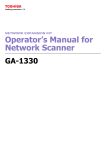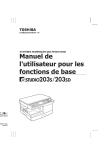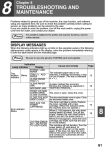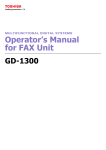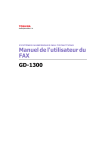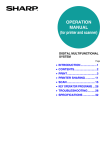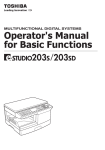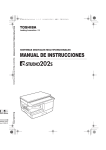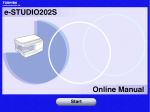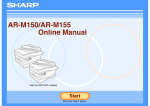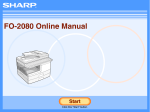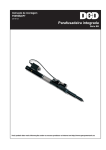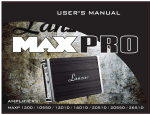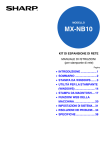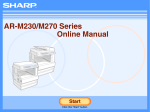Download Toshiba GA-1330 Network Hardware User Manual
Transcript
GA-1330
Network expansion kit Online Manual
(for network printer)
Start
Click this "Start" button.
Introduction
The optional network expansion kit enables the machine to be used as a network printer.
This manual explains the network printer functions that can be used when the network expansion kit is installed.
To use the machine as a PS printer, the PS3 expansion kit (GA-1180) must be installed. After installing the expansion kit, the product key
(password) must be entered in "Product Key Setting" in the Web page (this is only required once). Please consult your dealer for the product
key to be entered.
●
Note
This manual refers to the Multifunctional Digital Systems e-STUDIO203S/203SD as "the machine".
For information on copier functions, adding paper and toner, removing misfeeds, using peripheral equipment, and other general
information, see the operation manual for the machine. For information on the scanner functions that can be used when the
network expansion kit is installed, see the online manual for network scanner that accompanies the network expansion kit.
● The machine's default settings and default settings for the printer function can be changed using the user programs. For more
information, see the operation manual for the machine.
● Where "e-STUDIOXXXX" appears in this manual, please substitute the name of your model.
● This manual refers to the Reversing Automatic Document Feeder as the "RADF".
● The explanations of screens and procedures in this manual are primarily for Windows® XP in Windows® environments, and Mac
OS X v10.4 in Macintosh environments. The screens may vary in other versions of the operating systems.
● For information on using your operating system, refer to your operating system's manual or online Help.
● The PS3 expansion kit (GA-1180) mentioned in this manual is an option.
●
Trademark Acknowledgments
Microsoft®, Windows®, Windows® 98, Windows® Me, Windows® 2000, Windows® XP, Windows Server® 2003, Windows Vista® and Internet
Explorer® are registered trademarks or trademarks of Microsoft Corporation in the U.S.A. and other countries.
● Macintosh, Mac OS, AppleTalk, EtherTalk and LaserWriter are trademarks or Apple Inc., registered in the U.S. and other countries.
● Adobe, the Adobe logo, Acrobat, the Adobe PDF logo, and Reader are registered trademarks or trademarks of Adobe Systems Incorporated
in the United States and other countries.
● PCL is a registered trademark of the Hewlett-Packard Company.
● PostScript is a registered trademark of Adobe Systems Incorporated.
● All other trademarks and copyrights are the property of their respective owners.
●
The display screens, messages, and key names shown in the manual may differ from those on the actual machine due to product
improvements and modifications.
CONTENTS
I N D E X
2
How to use the online manual
This section explains how to view the online manual. Please read this section before using the online manual.
For information on using Acrobat Reader, see Acrobat Reader Help.
How to Control the Online Manual
Following Links
In this manual, the following buttons are displayed at the bottom
of each page. Click these buttons to move quickly to pages that
you wish to view.
This manual uses a link function that allows you to jump to a
related page. If you click green, underlined text, the related
page will be displayed. (In the Contents and Index sections, the
linked areas are not underlined.)
Example: ☞Contents
To return to the previous page, click the button on the menu
bar of Acrobat Reader.
CONTENTS
Displays the Contents of this manual. Click on a topic in the
Contents to jump directly to that section.
Using Bookmarks
Bookmarks have been created on the left side of this manual.
You can click on a bookmark to jump directly to that section.
I N D E X
Displays the Index of this manual. Click on a topic in the Index
to jump directly to that section.
How to Print Out This Manual
To print this manual, select "Print" from the "File" menu of
Acrobat Reader. Select the desired printer settings in the "Print"
dialog box, and then click the "OK" button.
Takes you forward page by page.
Takes you back page by page.
CONTENTS
I N D E X
3
Contents
Introduction
How to use the online manual
(part 1)
2
3
2 PRINTER UTILITIES (WINDOWS)
Printer utilities
●
1 PRINTING FROM WINDOWS
Basic printing
If the tray runs out of paper during printing
Cancel a print job
● When "Paper Source" is set to "Auto Select"
●
Opening the printer driver from the "start" button
Printer driver settings
Two-sided printing
●
Pamphlet style
●
How to Print a Watermark
17
8
9
10
12
13
14
15
18
●
Starting up the printer utilities
● Using the printer utilities
● Changing the Printer Status Monitor settings
● Checking the printer status
18
18
19
20
3 PRINTING FROM MACINTOSH
Basic printing
21
●
If the tray runs out of paper during printing
Cancel a print job
● When "Paper Feed" is set to "Auto Select"
22
22
22
●
15
Printing text and lines/graphics in black
●
Printing text in black
● Printing lines and vector graphics in black
CONTENTS
7
7
7
11
Printing multiple pages on one page
Fitting the printed image to the paper
Rotating the print image 180 degrees
Printing a watermark
Before using the Printer Status Monitor
Using the printer utilities
6
●
17
I N D E X
16
16
16
4
Contents
(part 2)
4 WEB FUNCTIONS IN THE MACHINE
About the Web pages
●
23
How to access the Web page and view help
About the Web pages (for users)
Directly printing a file in a computer
●
5 TROUBLESHOOTING
Advanced job settings
23
24
25
25
Configuring the printer condition settings
●
How to configure the settings
Printer condition setting menu
● Printer condition settings
●
Setting up the E-mail print function
● Using the E-mail print function
Key operator programs
●
●
Check the connections
41
Removing the software
42
●
Windows
● Macintosh (Mac OS 9.0 to 9.2.2)
42
42
27
28
29
34
35
6 SPECIFICATIONS
Printer specifications
Printer driver specifications
43
44
7 INDEX
36
Configuring a setting in the key operator programs
Key operator programs
E-mail status and e-mail alert settings
●
Information setup
SMTP setup
● Status message setup
● Alerts message setup
36
37
38
38
38
39
40
●
CONTENTS
●
41
26
About the Web pages (for the administrator)
32
Protecting information programmed in the web page ([Passwords]) 33
E-mail print function
34
●
Troubleshooting
I N D E X
5
1
PRINTING FROM WINDOWS
Basic printing
(part 1)
The following example explains how to print a document from WordPad.
Before printing, make sure that the correct size of paper for your document has been loaded in the machine.
1
Start WordPad and open the document that you
wish to print.
2
Select "Print" from the application's "File"
menu.
3
Make sure that "TOSHIBA e-STUDIOXXXX" is
selected as the printer. If you need to change any
print settings, click the "Preferences" button
("Properties" button in Windows 98/Me) to open
the printer driver setup screen.
The printer driver setup screen will appear.
The "Print" dialog box will appear.
Windows 2000 does not have the "Preferences" button
in this dialog box. Select settings as needed on each of
the tabs in the setup screen.
☞Printer driver settings, Two-sided printing,
Printing multiple pages on one page,
Fitting the printed image to the paper,
Rotating the print image 180 degrees,
Printing a watermark
4
Click the "Print" button ("OK" button in
Windows 98/Me).
Printing begins.
The print job is delivered to the output tray, with the
position of the paper offset slightly from the previous job
(offset function).
CONTENTS
I N D E X
6
1
PRINTING FROM WINDOWS
Basic printing
(part 2)
If the tray runs out of paper during printing
When "Paper Source" is set to "Auto Select"
Printing will automatically resume when paper is loaded in the
tray.
When using the bypass tray, select printer mode with the mode
select key on the machine, load paper as instructed by the
message in the display, and then press the [START] key to
resume printing.
If "Paper Source" is set to "Auto Select" in the "Paper" tab of the
printer driver setup screen and the correct size of paper for a
print job is not loaded in the machine, the printing procedure will
vary depending on the "FORCED OUTPUT" setting in the user
programs (see "USER PROGRAMS" in the Operation Manual).
When the 250-sheet paper feed unit is installed:
Select printer mode with the mode select key on the machine,
check the message in the display, load paper in the bypass tray,
and then press the [START] key to begin printing.
Note that if the "AUTO TRAY SWITCH" setting in the user
programs is enabled and there is the same size of paper in
another tray, the machine will automatically switch to the other
tray and continue printing.
When "FORCED OUTPUT" is set to "OFF"
When "FORCED OUTPUT" is set to "ON"
Printing takes place on the paper loaded in the machine, even
though the paper size is different from the print image size.
Cancel a print job
To cancel a print job that is already in progress, select printer
mode with the mode select key on the machine and then press
the [CLEAR] key ( ) or the [CLEAR ALL] key ( ).
"CANCEL PRINT JOB?" will appear in the display. Select "YES"
and press the [ENTER] key.
CONTENTS
I N D E X
7
PRINTING FROM WINDOWS
1
Opening the printer driver from the "start" button
Printer driver settings can be configured by opening the printer driver from the Windows "start" button. Settings adjusted in this way
will be the initial settings when you print from an application. (If you change the settings in the printer driver setup screen at the time
of printing, the settings will revert to the initial settings when you quit the application.)
Windows 2000/XP/Server 2003/Vista
1
Click the "start" button, and then click "Control
Panel".
On Windows 2000, click the "Start" button and select
"Settings".
● On Windows Server 2003, click the "Start" button and
then click "Printers and Faxes". Go to step 3.
●
2
1
2
Click the "Start" button, select "Settings" and
then click "Printers".
3
On Windows 98/Me, click the "Setup" tab.
Click the "TOSHIBA e-STUDIOXXXX" printer
driver icon and select "Properties" from the
"File" menu.
Click "Printers and Other Hardware", and then
click "Printers and Faxes".
●
●
3
Windows 98/Me
On Windows Vista, click "Printer".
On Windows 2000, click "Printers".
Click the "TOSHIBA e-STUDIOXXXX" printer
driver icon and select "Properties" from the
"File" menu.
The printer driver setup screen will appear.
☞Printer driver settings
On Windows Vista, select "Properties" from the "Organize" menu.
4
Click the "Printing Preferences" button in the
"General" tab.
The printer driver setup screen will appear.
☞Printer driver settings
CONTENTS
I N D E X
8
1
PRINTING FROM WINDOWS
Printer driver settings
To view Help for a setting, click the
button in the upper right-hand corner of the window and then click the setting.
Some restrictions exist on the combinations of settings that can be selected in the printer driver setup screen. When a restriction is
in effect, an information icon (
) will appear next to the setting. Click the icon to view an explanation of the restriction.
1 Tab
6 Check button
The settings are grouped
Allows you to select one
1
on tabs. Click on a tab to
item from a list of options.
bring it to the front.
7 "OK" button
2
2 Drop-down list
Click this button to save
your settings and exit the
Allows you to make a
3
dialog box.
selection from a list of
choices.
8 "Cancel" button
Click this button to exit the
3 Print setting image
dialog box without making
This shows the effect of the
any changes to the
selected print settings.
4
settings.
4 Checkbox
9 "Apply" button
Click on a checkbox to
5
Click to save your settings
activate or deactivate a
without closing the dialog
function.
box.
5 Machine image
6
10 "Help" button
The paper tray (in blue)
7
Click this button to display
selected in "Paper selection"
8
the help file for the printer
on the "Paper" tab.
driver.
9
You can also click on a tray
10
to select it.
Note
The settings and the image of the machine will vary depending on the model.
The printer driver setup screen allows you to select various functions that can be used when the
network expansion kit is installed.
For information on the printer functions of the network expansion kit, see "Printer driver specifications".
CONTENTS
I N D E X
9
1
PRINTING FROM WINDOWS
Two-sided printing
(part 1)
The printer driver setup screen of models that support two-sided printing contains a "Document
Style" setting in the "Main" tab. This feature allows you to print on both sides of the paper.
To use this function, open the printer driver setup screen and select "2-Sided (Book)" or
"2-Sided (Tablet)" from "Document Style" in the "Main" tab.
☞See Basic printing for details on how to open the printer driver.
●
Note
●
Paper sizes that can be used for two-sided printing are Letter, Legal, Folio*, Invoice, A4, A5, B5, Foolscap, and 16K.
When using two-sided printing, select a source other than "Bypass Tray" for the "Paper Source" in the "Paper" tab.
* For two-sided printing on Folio size paper, "Tray 1" or "Tray 2" (if Tray 2 has been installed) must be selected in the "Paper
Source" on the "Paper" tab.
The following example shows the result when portrait data is printed on both sides of the paper.
Print data
Printing result
2-Sided (Book)
2-Sided (Tablet)
The pages are printed so that The pages are printed so that
they can be bound at the side. they can be bound at the top.
CONTENTS
I N D E X
10
1
PRINTING FROM WINDOWS
Two-sided printing
(part 2)
Pamphlet style
Pamphlet style prints two pages each on the front and back of each sheet of paper (four pages total on
one sheet) so that the sheets can be folded down the center and bound to create a pamphlet. This
function is convenient when you wish to compile printed pages into a pamphlet.
To use this function, open the printer driver and select "Pamphlet Style" in "Document Style" in the
"Main" tab.
The direction of opening of the pamphlet can be selected with the "Right Turning Pamphlet" checkbox in
the "Advanced" tab. The following examples show how 8 pages are printed when pamphlet style is
selected.
Printing result
Print data
Right Turning Pamphlet
Right Turning Pamphlet
●
Note
Only letter, invoice, A4 and A5 size paper can be used for pamphlet style printing.
Because four pages are printed on each sheet of paper, blank pages are automatically added at the end when the total number
of pages is not a multiple of four.
● When "Tiled Pamphlet" is selected, printing will take place on paper that is twice the size of the paper size specified in the application.
● When "2-Up Pamphlet" is selected, each page is reduced in the same way as for 2-Up and printed on the size of paper that is
specified in the application.
●
CONTENTS
I N D E X
11
1
PRINTING FROM WINDOWS
Printing multiple pages on one page
This feature allows you to reduce and print two, four, six, eight or sixteen document pages on a single sheet of paper.
To use this function, open the printer driver setup screen and select the number of pages per sheet (2-Up, 4-Up, 6-Up, 8-Up, or
16-Up) in "N-Up Printing" in the "Main" tab.
The order of the pages can be changed in the "Order" menu.
☞See Basic printing for details on how to open the printer driver.
Note
The "N-Up Printing" setting is not available when "Fit To Paper Size" is selected.
☞Fitting the printed image to the paper
For example, when "2-Up" or "4-Up" is selected, the result will be as follows depending on the selected order.
N-Up
Left to Right
Right to Left
[2-Up]
N-Up
Right , and Down Down , and Right
Left , and Down
Down , and Left
[4-Up]
If you select the "Border" checkbox, borderlines will be printed around each page.
Note
Examples for 2-Up and 4-Up are shown here. The order of 6-Up, 8-Up, and 16-Up is the same as 4-Up. The order can be viewed
in the print setting image in the printer driver setup screen.
☞Printer driver settings
CONTENTS
I N D E X
12
PRINTING FROM WINDOWS
1
Fitting the printed image to the paper
The printer driver can adjust the size of the printed image to match the size of the paper loaded in the machine.
Follow the steps shown below to use this function. The explanation below assumes that you intend to print a letter size document on
invoice size paper.
☞See Basic printing for details on how to open the printer driver.
Note
1
2
3
The "Fit To Paper Size" setting is not available when "N-Up Printing" is selected.
☞Printing multiple pages on one page
Click the "Paper" tab in the printer driver setup
screen.
Select the original size (Letter) of the print
image in "Paper Size".
4
Select the actual size of paper to be used for
printing (Invoice).
The size of the printed image will be automatically
adjusted to match the paper loaded in the machine.
Paper Size: Letter
Fit To Paper Size: Invoice
Check the "Fit to Page" box.
When using the PS printer driver, select "Fit To Paper
Size" in "Zoom Setting".
Letter size document
(Paper Size)
Invoice size paper
(Fit To Paper Size)
●
Note
If "A3 [Fit to Page]", "B4 [Fit to Page]", or "Ledger [Fit to Page]" is selected, the print image is fit to the letter size even if "Fit to
Page" is not selected.
● When using the PS printer driver, the print image can be enlarged or reduced by means of numerical values. (The vertical and horizontal
ratios can be set separately.) Select "XY-Zoom" in step 3, click the "Width/Length" button, and adjust the ratios in the screen that appears.
CONTENTS
I N D E X
13
1
PRINTING FROM WINDOWS
Rotating the print image 180 degrees
The print image can be rotated 180 degrees.
This feature is used to enable correct printing on envelopes and other paper with flaps that can
only be loaded in one orientation.
To use the feature, select the image orientation in "Image Orientation" on the "Paper" tab, and
then select the "Rotate 180 degrees" checkbox.
☞See Basic printing for details on how to open the printer driver.
Printing result
Rotate 180 degrees
ABCD
Note
Rotate 180 degrees
ABCD
The procedure for loading paper is explained in the operation manual for the machine.
CONTENTS
I N D E X
14
1
PRINTING FROM WINDOWS
Printing a watermark
You can print a watermark such as "CONFIDENTIAL" on your document. To print a watermark, open the printer driver, click the
"Watermarks" tab, and follow the steps below.
☞See Basic printing for details on how to open the printer driver.
How to Print a Watermark
From the "Watermark" drop-down list, select the watermark that you wish to print (for example "CONFIDENTIAL"), and start printing.
Print sample
You can enter text to create your own custom watermark. For details on watermark settings, view printer driver Help.
☞Printer driver settings
CONTENTS
I N D E X
15
PRINTING FROM WINDOWS
1
Printing text and lines/graphics in black
Color text, lines and vector graphics that are faint when printed normally can be printed in black to improve legibility.
Printing text in black
Printing lines and vector graphics in black
Text that is any color other than white is printed in black.
To use this function, open the printer driver setup screen and
select the "Text To Black" checkbox in the "Advanced" tab.
Lines and vector graphics that are any color other than white
are printed in black.
To use this function, open the printer driver setup screen and
select the "Vector To Black" checkbox in the "Advanced" tab.
Print data
ABCD
EFGH
Printing result
Text To Black
Text To Black
ABCD
EFGH
Print data
Printing result
Vector To Black
Vector To Black
ABCD
EFGH
●
Note
When using the PCL6 printer driver, if "Print as
graphics" is selected in "TrueType Mode" of "Font" in
the "Advanced" tab, this function cannot be used.
● When using the PCL5e printer driver, if "Raster" is
selected in "Graphics mode" in the "Advanced" tab,
this function cannot be used.
CONTENTS
I N D E X
Note
When using the PCL6 or PCL5e printer driver, if "Raster"
is selected in "Graphics mode" in the "Advanced" tab,
this function cannot be used.
16
2
PRINTER UTILITIES (WINDOWS)
Printer utilities
Printer Status Monitor (for general users)
Before using the Printer Status Monitor
"Printer Status Monitor" is on the "Software CD-ROM" (Disc 1).
This allows the user to check on the computer screen whether
or not the machine is able to print.
It provides information on error states such as paper misfeeds
and shows the configuration of the machine (number of trays,
etc.) by means of illustrations. Available paper sizes and paper
remaining are also indicated.
Note the following points before using the Printer Status
Monitor.
When the first print job is executed after starting up the Printer
Status Monitor, the machine's IP address is automatically set in
the Printer Status Monitor.
Printer Administration Utility (for administrators)
Direct printing without a server
"Printer Administration Utility" is on the "Software CD-ROM"
(Disc 2).
This allows the administrator to check information on supplies
and error states of the machine and other TOSHIBA printers
(compatible with the Printer Administration Utility) that are
connected to the network. Settings can also be changed via the
utility.
Install and configure the software as explained in "INSTALLING
THE PRINTER DRIVER" in the software setup guide for
network printer. (This is not necessary if the software has
already been installed and configured.)
Printing via a server
●
Note
In order to use the Printer Status Monitor and Printer
Administration Utility, the machine must be connected
to a network.
● To install the Printer Status Monitor, see the network
expansion kit online manual (for setup).
CONTENTS
I N D E X
17
2
PRINTER UTILITIES (WINDOWS)
Using the printer utilities
(part 1)
Starting up the printer utilities
Using the printer utilities
If the Printer Status Monitor or Printer Administration Utility is
not running, use the following procedure to start the utilities.
For information on using the Printer Status Monitor and Printer
Administration Utility, see the Help files for each. The Help files
can be viewed as follows:
Note
When the Printer Administration Utility is first started up,
the TCP/IP settings window appears. To monitor the
machine on a local network, select the "Local Subnet
Search" checkbox. Otherwise, enter the machine's IP
address. For more information, see the Help file.
Printer Status Monitor
Click the "Start" button, point to "All Programs" ("Programs" in
operating systems other than Windows XP/Server 2003/Vista)
and then "TOSHIBA Printer Status Monitor". Select "Help".
Printer Status Monitor
Printer Administration Utility
Click the "Start" button, point to "All Programs" ("Programs" in
operating systems other than Windows XP/Server 2003/Vista)
and then "TOSHIBA Printer Status Monitor". Select "Printer
Status Monitor".
Click the "Start" button, point to "All Programs" ("Programs" in
operating systems other than Windows XP/Server 2003/Vista)
and then "TOSHIBA Printer Administration Utility". Select
"Help".
Printer Administration Utility
Click the "Start" button, point to "All Programs" ("Programs" in
operating systems other than Windows XP/Server 2003/Vista)
and then "TOSHIBA Printer Administration Utility". Select
"Printer Administration Utility".
CONTENTS
I N D E X
18
PRINTER UTILITIES (WINDOWS)
2
Using the printer utilities
(part 2)
Changing the Printer Status Monitor settings
Once installed, the Printer Status Monitor normally runs in the background in Windows. If you need to change the Printer Status
Monitor settings, follow the steps below.
1
Right-click the Printer Status Monitor icon ( )
on the task bar, and select "Preferences" from
the pop-up menu.
Note
2
Change the Printer Status Monitor settings as
desired.
For information on the Printer Status Monitor settings,
see Printer Status Monitor Help. (Click the "Help" button
in the settings window.)
If the Printer Status Monitor icon does not appear on the
task bar, see "Starting up the printer utilities" to start the
Printer Status Monitor.
CONTENTS
I N D E X
19
PRINTER UTILITIES (WINDOWS)
2
Using the printer utilities
(part 3)
Checking the printer status
The Printer Status Monitor allows you to check whether or not toner and paper remain in the machine.
1
Right-click the Printer Status Monitor icon ( )
on the task bar, and select "TOSHIBA
e-STUDIOXXXX Status" from the pop-up menu.
Note
2
The icon turns red when printing is not possible due to a
machine error or other problem.
Click the "Detail" button.
To collapse the window, click the "Hide detail" button.
The window expands to show machine status details.
Note
CONTENTS
I N D E X
By default, the collapsed window initially appears when
"TOSHIBA e-STUDIOXXXX Status" is selected in Step
1. If desired, you can change the setting to have the
expanded window initially appear.
☞Changing the Printer Status Monitor settings
20
PRINTING FROM MACINTOSH
3
Basic printing
(part 1)
To use the machine as a printer for the Macintosh, the PS3 expansion kit (GA-1180) must be installed and the machine must be
connected to a network. To install the PPD file and configure the printer driver settings, see the software setup guide.
Before printing, make sure that the correct size of paper for your document has been loaded in the machine.
1
Start the application and open the document
that you wish to print.
2
Select "Print" from the application's "File"
menu.
3
Make sure that the correct printer is selected.
4
Configure print settings.
Click
next to "Copies &
Pages" ("General" in Mac OS
9.0 to 9.2.2) and select the
settings that you wish to
configure from the pull-down
menu. The corresponding
setting screen will appear.
Note
5
Note
The settings vary depending on the operating system
version, the printer driver version, and the application.
Click the "Print" button.
The Print window varies depending on the operating
system version, the printer driver version, and the
application.
Printing begins.
CONTENTS
I N D E X
21
3
PRINTING FROM MACINTOSH
Basic printing
(part 2)
If the tray runs out of paper during printing
When "Paper Feed" is set to "Auto Select"
Printing will automatically resume when paper is loaded in the
tray.
When using the bypass tray, select printer mode with the mode
select key on the machine, load paper as instructed by the
message in the display, and then press the [START] key to
resume printing.
If "Paper Feed" is set to "Auto Select" in the Print window and the
correct size of paper for a print job is not loaded in the machine,
the printing procedure will vary depending on the "FORCED
OUTPUT" setting in the user programs (see "USER
PROGRAMS" in the Operation Manual).
When the 250-sheet paper feed unit is installed:
Select printer mode with the mode select key on the machine,
check the message in the display, load paper in the bypass tray,
and then press the [START] key to begin printing.
Note that if the "AUTO TRAY SWITCH" setting in the user
programs is enabled and there is the same size of paper in
another tray, the machine will automatically switch to the other
tray and continue printing.
When "FORCED OUTPUT" is set to "OFF"
When "FORCED OUTPUT" is set to "ON"
Printing takes place on the paper loaded in the machine, even
though the paper size is different from the print image size.
Cancel a print job
To cancel a print job that is already in progress, select printer
mode with the mode select key on the machine and then press
the [CLEAR] key ( ) or the [CLEAR ALL] key ( ).
"CANCEL PRINT JOB?" will appear in the display. Select "YES"
and press the [ENTER] key.
CONTENTS
I N D E X
22
4
WEB FUNCTIONS IN THE MACHINE
About the Web pages
The network expansion kit includes a built-in Web server. The Web server is accessed using a Web browser on your computer. The Web
pages include both pages for users and pages for the administrator. In the user Web pages, users can monitor the machine, directly print
a file specified on a computer, and select printer configuration settings. In the administrator Web pages, the administrator can configure
the machine's e-mail settings, settings for print by e-mail, and passwords. Only the administrator is allowed to configure these settings.
How to access the Web page and view help
Use the following procedure to access the Web pages. [Help] can be clicked at the bottom of the menu frame to view information on
the various function settings that can be configured remotely over the network from the machine's Web pages. For the settings of
each function, see the explanations in Help.
1
2
Open the Web browser on your computer.
Supported browsers:
Internet Explorer 5.5 or later (Windows)
Netscape Navigator 6.0 or later
3
Click the [Help] button at the bottom of the
menu frame.
To view information on a function
setting, click the corresponding
item in the Help screen.
In the "Address" field of your Web browser,
enter the IP address that has been configured in
the machine.
4
When the connection is completed, the Web page will
appear in your Web browser.
When finished, close the Web pages.
When you have finished using
the Web pages, click the
(close) button in the top right
corner of the page.
☞About the Web pages (for users)
CONTENTS
I N D E X
23
4
WEB FUNCTIONS IN THE MACHINE
About the Web pages (for users)
When you access the user Web pages in the machine, the following page will appear in your browser.
A menu frame appears on the left side of the page. When you click an item in the menu, a screen appears in the right frame that
allows you to configure settings for that item.
(1)
(2)
(3)
(4)
(5)
(6)
(1)Menu frame
Click a setting in the menu to configure it.
(2)System Information
Shows the current status of the machine and model name.
• Device Status
Shows the current status of the machine, paper trays,
output trays, toner and other supplies, and page counts.
Out of paper and other warnings appear in red.
• Device Configuration
Shows what options are installed.
CONTENTS
I N D E X
• Network Status
Shows the network status. Information on "General",
"TCP/IP", "NetWare", "AppleTalk", and "NetBEUI" is shown
on the respective pages.
(3)Submit Print Job
A file on a computer can be printed out.
☞Directly printing a file in a computer
(4)Printer Test Page
The "Printer Settings List" and various font lists can be
printed.
(5)Condition Settings
Configure basic printer settings.
☞Configuring the printer condition settings
(6)Admin Mode
To open the Web pages for the administrator, click here and
then enter the administrator's user name and password.
☞About the Web pages (for the administrator)
☞Protecting information programmed in the web page
([Passwords])
24
4
WEB FUNCTIONS IN THE MACHINE
Directly printing a file in a computer
A file that can be accessed by your computer can be directly printed without using the printer driver by specifying the file's address.
Any file that can be accessed by your computer can be printed by this method, including not only files on your computer but files on
other computers connected to the same network.
To directly print a file by this method, click [Submit Print Job] in the menu frame of the Web page.
1
Click [Submit Print Job] in the link menu.
The "Submit Print Job" screen
will appear.
3
Click [Browse] and select the file that you wish
to print.
You can also directly enter the file name (with the path).
4
Click [Print].
Printing begins.
Advanced job settings
2
Select the print format in "Job Detail".
The settings are described in the table below.
CONTENTS
I N D E X
Item
Description
Factory
default setting
Copies
Set the number of copies from 1 to 999.
1
Paper Size
Select the size of paper to be used for
printing.
Not Specified
Orientation
Select the printing orientation. (Portrait /
Portrait
Landscape)
Binding
Edge
Select the binding position for two-sided
Left
printing. (Left / Top)
Duplex
To print on both sides of the paper, select
Not selected
this checkbox. (Only for models that
support the two-sided printing.)
25
4
WEB FUNCTIONS IN THE MACHINE
Configuring the printer condition settings
(part 1)
The printer condition settings allow basic printer settings to be configured. The following items can be set:
Default Settings: Basic settings that are mainly used when
the printer driver is not used.
● PCL Settings:
PCL symbol set, font, line feed code, and
other settings.
●
Note
PostScript Settings*:
Sets whether or not a PostScript
error page is printed when a
PostScript error occurs.
* This setting is only appears when the PS3 expansion kit is
installed.
●
When the printer driver is used and the same settings are configured both in the printer driver and in the above screens, the settings
configured in the printer driver override the settings in the above screens. If a setting is available in the printer driver, use the printer
driver to configure the setting.
CONTENTS
I N D E X
26
4
WEB FUNCTIONS IN THE MACHINE
Configuring the printer condition settings
(part 2)
How to configure the settings
To display the Condition Settings screen, click [Condition Settings] in the menu frame.
For detailed explanations of the procedures for establishing settings, click [Help] in the menu frame.
(2)
(3)
(1)
(4)
(1)Condition Settings
This displays the page for configuring the printer condition
settings.
(2)Default / PCL / PS
Select the type of condition settings that you wish to
configure.
CONTENTS
I N D E X
(3)Settings
The factory default settings are displayed.
Change the settings as desired by selecting from drop-down
lists and by directly entering settings.
For information on the settings, see "Printer condition settings".
(4)Submit
Click to store the Web page settings in the machine.
27
4
WEB FUNCTIONS IN THE MACHINE
Configuring the printer condition settings
(part 3)
Printer condition setting menu
Click on a setting to view an explanation of the setting.
Condition Settings
Default Settings
Condition Settings
Factory default settings
PCL Settings
Factory default settings
Copies
1
Symbol Set
PC-8
Orientation
Portrait
Font
0: Courier (internal font)
Default Paper Size
Letter
Line Feed Code
CR=CR; LF=LF; FF=FF
Default Paper Source
Auto
Wide A4
Disable
2-Sided Print
1-Sided
ROPM (Rip Once, Print Many) Enable
PostScript Settings*
Print PS Errors
Factory default settings
Disable
* This setting is only appears when the PS3 expansion kit is
installed.
CONTENTS
I N D E X
28
4
WEB FUNCTIONS IN THE MACHINE
Configuring the printer condition settings
(part 4)
Printer condition settings
Factory default settings are indicated in bold.
Default Settings
Item
Copies
Orientation
Selections
1 - 999
Portrait, Landscape
Default Paper Size
Invoice, Letter,
Foolscap, Legal
Default Paper Source
Auto,
Tray 1,
Tray 2*,
Bypass (Auto)
1-Sided,
2-Sided (Book),
2-Sided (Tablet)
2-Sided Print
ROPM (Rip Once, Print
Many)
CONTENTS
Enable, Disable
I N D E X
Description
This is used to select the number of copies.
This sets the orientation of the printed page. Select [Portrait] when the image
is longer in the vertical direction, or [Landscape] when the image is longer in
the horizontal direction.
This sets the default paper size used for the printed image. Even if the set size
of paper is not in any of the trays, the printed image is formed in accordance
with this setting.
Set the default paper tray.
*Selections available depend on the trays that are installed.
When [2-Sided (Book)] is selected, two-sided printing takes place so as to allow
binding at the left side. When [2-Sided (Tablet)] is selected, two-sided printing
takes place so as to allow binding at the top. (Only for models that support
two-sided printing.)
This enables the ROPM function. When enabled, multi-page print jobs are
stored in memory before printing, and thus the computer does not need to
repeatedly send the print data when multiple copies are printed.
29
4
WEB FUNCTIONS IN THE MACHINE
Configuring the printer condition settings
(part 5)
PCL Settings
Item
Symbol Set
Selections
Select one of 35 sets.
Font
Select one internal or
one external font.
Line Feed Code
CR=CR; LF=LF;
FF=FF,
CR=CR+LF; LF=LF;
FF=FF,
CR=CR; LF=CR+LF;
FF=CR+FF,
CR=CR+LF; LF=CR+LF;
FF=CR+FF
Enable, Disable
Wide A4
CONTENTS
I N D E X
Description
This specifies which country's characters (PCL symbol set) are assigned to
certain of the symbols in the character code list. The factory default setting is
[PC-8].
This specifies which PCL font to use for printing. One font can be specified from
among the internal fonts and extended fonts (when the barcode font kit or the
Flash ROM kit is installed). The factory default setting is [0: Courier].
This specifies the line break code by means of a combination of the "CR"
(return) code, "LF" (line break) code, and "FF" (page break) code. The factory
default setting is printing based on the transmitted code. The setting can be
changed by selecting one of four combinations.
This setting can be enabled to print 80 lines on A4 size paper with each line
10CPI font (English characters). When the setting is disabled (a checkmark
does not appear), each line is 78 characters long.
30
4
WEB FUNCTIONS IN THE MACHINE
Configuring the printer condition settings
(part 6)
PostScript Settings
The "PostScript Settings" are only effective when the PS3 expansion kit is installed.
Item
Print PS Errors
CONTENTS
Selections
Enable, Disable
I N D E X
Description
When this setting is enabled, an error description is printed each time a
PostScript error occurs.
31
4
WEB FUNCTIONS IN THE MACHINE
About the Web pages (for the administrator)
In addition to the menus that appear for users, other menus that can only be used by the administrator appear in the administrator Web pages.
A menu frame appears on the left side of the page. When you click an item in the menu, a screen appears in the right frame that
allows you to configure settings for that item. Settings that can only be configured by the administrator are explained here.
(1)
(2)
(3)
(4)
(5)
(6)
(7)
(8)
(1)Information
Configure machine identification information for the status &
alert E-mail function.
☞Information setup
(2)Passwords
To protect the Web site, the system administrator can
establish passwords. Enter a password that you would like to
establish and click the [Submit] button.
CONTENTS
I N D E X
One password can be established for the administrator and
one password can be established for users.
☞Protecting information programmed in the web page
([Passwords])
(3)Key Operator Programs
Setting changes can be prohibited and interface settings can
be configured.
☞Key operator programs
(4)Status Message
Configure parameters required for sending status
messages, such as destination addresses and time
schedules.
☞Status message setup
(5)Alerts Message
Store destination addresses for alert messages.
☞Alerts message setup
(6)Security
Unused ports can be disabled for greater security and port
numbers can be changed.
(7)Services
Configure information concerning the e-mail system.
☞SMTP setup
(8)Print Port
Configure settings for e-mail print.
☞Setting up the E-mail print function
32
WEB FUNCTIONS IN THE MACHINE
4
Protecting information programmed in the web page ([Passwords])
Passwords can be set (click [Passwords] in the menu frame) to restrict Web page access and protect settings. The administrator
must change the password from the factory default setting. The administrator must also take care to remember the new password.
The next time the Web pages are accessed, the new password must be entered.
A password can be set for the administrator and a password can be set for users.
1
Click [Passwords] in the menu frame.
3
Enter passwords in "User Password" and
"Admin Password".
• A maximum of 7 characters and/or numbers can be
entered for each password (passwords are case
sensitive).
• Be sure to enter the same password in "Confirm
Password" as you did in "New Password".
2
Enter the current password in "Admin
Password".
When establishing a password for the first time, enter
"TOSHIBA" in "Admin Password".
Caution
Be sure to enter "TOSHIBA" in upper case
(passwords are case sensitive).
CONTENTS
I N D E X
4
When you have finished entering all items, click
[Submit].
The entered password is stored.
After setting the password, turn the machine power
off and then back on.
Note
When prompted to enter a password, a user should
enter "user" and an administrator should enter "admin"
in "User Name". In "Password", the respective password
for the entered user name should be entered.
For more information, click [Help] in the upper right-hand
corner of the window.
33
4
WEB FUNCTIONS IN THE MACHINE
E-mail print function
(part 1)
An e-mail account can be set up for the machine. When this is done, the machine will periodically check the e-mail server for e-mail
and automatically print out any file attachments it receives. This provides a means for printing a file from a computer that does not
have the printer driver installed, as the user can simply send the file to the machine as an e-mail attachment.
Setting up the E-mail print function
To use the e-mail print function, the machine must have an e-mail account.
1
Click [Print Port] in the menu frame.
3
For detailed information, Click [Help] in the upper
right-hand corner of the window.
The "Print Port Setup" page
appears.
4
2
Enter the information regarding the e-mail
environment.
Click [Submit] to store the entered information.
Click [E-mail print].
CONTENTS
I N D E X
34
WEB FUNCTIONS IN THE MACHINE
4
E-mail print function
(part 2)
Using the E-mail print function
To use the e-mail print function, attach the file that you wish to print to an e-mail message and send the e-mail to the machine's
e-mail address.
The machine can print the following file types:
PCLXL, PCL5e, PS, PDF, and TIFF, with file extensions pcl, ps, pdf, tiff, and tif
Control commands can be entered in the message of the e-mail to specify the number of copies and print format. Commands are
entered in the format "command name = value".
The following control commands can be entered:
Function
Command name
Value
Entry example
Copies
COPIES
1-999
COPIES=2
Two-sided print
DUPLEX
OFF, TOP, LEFT
DUPLEX=LEFT
File type
LANGUAGE
AUTO, PCL, PCLXL, POSTSCRIPT, PDF, TIFF
LANGUAGE=TIFF
Paper
PAPER
Name of available paper (LETTER, etc.)
PAPER=A4
●
Note
Enter the commands in Plain Text format. If entered in Rich Text format (HTML), the commands will have no effect.
● To receive a list of the control commands, enter the command "Config" in the e-mail message.
● If an e-mail is sent with nothing entered in the message, printing will take place according to the settings in the condition settings
menu in the Web page "Default Settings".
● To print PS and PDF files, the PS3 expansion kit is required.
● An encrypted PDF file cannot be printed.
● Only enter a "File type" when you are specifying a page-description language. Normally there is no need to enter a file type.
CONTENTS
I N D E X
35
4
WEB FUNCTIONS IN THE MACHINE
Key operator programs
(part 1)
The key operator programs are used to prohibit changes to the [Condition Settings] and to configure interface settings.
• Default Settings: Select the setting for which you wish to prohibit changes.
• Interface settings: Enable monitoring of data sent to the network port and set restrictions.
Configuring a setting in the key operator programs
1
Click [Key operator programs] in the menu
frame.
The "Default Settings" screen of
the [Key operator programs] will
appear. If you wish to select a
setting in the "Default Settings"
screen, go to step 3.
2
3
Make a selection for the setting in the screen
that appears.
See Key operator programs for descriptions of the
settings.
4
Click [Submit] to store the entered information.
Click the desired setting.
CONTENTS
I N D E X
36
WEB FUNCTIONS IN THE MACHINE
4
Key operator programs
(part 2)
Key operator programs
When "YES, NO" appears in the "Settings" column, "YES" is selected when a checkmark appears in the checkbox of the item, and
"NO" is selected when checkmark does not appear.
Default settings
Item
Settings
Description
Prohibit Test
Page Printing
YES, NO
This setting is used to prohibit printing of a printer test page.
Disable Default
Setting Changes
YES, NO
This setting is used to prohibit changes to the default condition settings.
Disabling of
YES, NO
Clock Adjustment
This setting is used to prohibit changes to the date and time settings. This item does
not appear when the fax option is installed.
Interface settings
Item
Settings
Description
Hexadecimal
Dump Mode
YES, NO
This program is used to print out the print data from the computer in hexadecimal and
in the corresponding text characters (based on ASCII code). This allows you to check
whether or not print data is being correctly sent from the computer.
I/O Timeout
1- 60 - 999 (sec)
During reception of a print job, if remaining data is not received after the time set here
elapses, the port connection is broken and the next print job is begun.
Emulation
Switching
Auto*, PostScript*,
PCL
Select the printer language. When [Auto] is selected, the language is automatically
selected from the data sent to the printer. Unless errors occur frequently, do not
change the setting from [Auto] to another setting.
*Only when the PS3 expansion kit is installed.
Port Switching
Method
Switch at End of Job, Select the method for switching network ports.
Switch after I/O Timeout
CONTENTS
I N D E X
37
4
WEB FUNCTIONS IN THE MACHINE
E-mail status and e-mail alert settings
(part 1)
These functions send information on machine use (print count, copy count, etc.) and error conditions (paper misfeed, out of paper,
out of toner, etc.) via e-mail to the administrator of the machine or the dealer.
Information setup
SMTP setup
Machine identification information for the status and alert e-mail
functions is configured in the "Information Setup" screen. The
entered information will be included in status and alert e-mail
messages.
The Status and alert e-mail functions use SMTP (Simple Mail
Transport Protocol) to send e-mail. The following procedure is
used to set up the e-mail environment. This must be done by the
system administrator or other person familiar with the network.
1
Click [Information] in the menu frame.
The "Information Setup" screen
will appear.
2
Click [Services] in the menu frame.
2
Click [SMTP].
3
Enter the information required to set up the
e-mail environment.
The "Services Setup" screen will appear.
Enter the machine information.
For detailed information, click the [Help] button in the
upper right-hand corner of the window.
3
1
For detailed information, click the [Help] button in the
upper right-hand corner of the window.
Click [Submit] to store the entered information.
4
CONTENTS
I N D E X
Click [Submit] to store the entered information.
38
4
WEB FUNCTIONS IN THE MACHINE
E-mail status and e-mail alert settings
(part 2)
Status message setup
Use the status message function to send the current counter information, including the copy count, print count, and total output
count, basis on the specified schedule. The destinations can be set for administrators and dealers respectively.
To set up the status message, follow these steps.
1
Click [Status Message] in the menu frame.
The "Status Message Setup"
screen will appear.
3
Click [Submit] to store the entered information.
When the E-mail Status settings are completed, printer count
information will be sent periodically by e-mail to the specified
e-mail addresses.
Note
2
Enter the required information, including the
destination addresses and time schedule.
If you quit the browser before clicking [Submit], the
settings will be canceled. To send printer information
immediately to the specified e-mail addresses, click
[Send Now].
For detailed information, click the [Help] button in the
upper right-hand corner of the window.
CONTENTS
I N D E X
39
4
WEB FUNCTIONS IN THE MACHINE
E-mail status and e-mail alert settings
(part 3)
Alerts message setup
Use the alert message function to send alert information, such as empty toner and paper and trouble including paper misfeeds, to
specified destinations when such problems occur. The destinations can be set for administrators and dealers respectively.
To set up the alert message, follow the procedure below.
1
Click [Alerts Message] in the menu frame.
The "Alerts Message Setup"
screen will appear.
2
Enter the destination addresses.
For detailed information, click the [Help] button in the
upper right-hand corner of the window.
3
Click [Submit] to store the entered information.
If these parameters are set, event information for the printer will
be transmitted to the specified addresses via E-mail each time
a specified event occurs. The meaning of each event item is
shown below.
(Example)
Paper Jam: A paper misfeed has occurred.
Toner Low: Toner is low.
Toner Empty: Toner must be added.
Paper Empty: Paper must be loaded.
Note
CONTENTS
I N D E X
If you quit the browser before clicking [Submit], the
settings will be canceled.
40
5
TROUBLESHOOTING
Troubleshooting
This chapter explains how to solve network connection problems. For information on paper, removing misfeeds, and replacing the
toner cartridge, see the operation manual for the machine.
Check the connections
■ Is the LAN cable disconnected?
Make sure that the LAN cable is firmly inserted in the
connectors on the network expansion kit and your computer.
For information on connecting the LAN cable, see software
setup guide for network printer.
■ Is the machine configured for use on the same
network as the computer?
The machine cannot be used if it is not connected to the
same network as the computer, or if it is not configured for
use on the network.
For more information, consult your network administrator.
Points to check in Windows
■ Are you using a port that was created with Standard
TCP/IP Port?
Points to check on the Macintosh
■ Is AppleTalk enabled?
In Mac OS X, click "Network" in "System Preferences" and
select Ethernet in "Show". Click the "AppleTalk" tab and
make sure that "Make AppleTalk Active" is selected.
In Mac OS 9.0 to 9.2.2, open the "Chooser" from the Apple
menu and make sure that "Active" is selected. Printing is not
possible if "Active" is not selected.
■ Is "Ethernet" selected for the "Connect via" of
AppleTalk? (When using Mac OS 9.0 to 9.2.2.)
Open "AppleTalk" from the "Control Panels" and make sure
that "Ethernet" is selected in the "Connect via" menu.
Printing is not possible if "Ethernet" is not selected.
If you are using a port created using Standard TCP/IP Port in
Windows 2000/XP/Server 2003/Vista, printing may not take
place correctly if "SNMP Status Enabled" is selected in the
port settings of the printer driver. Open the printer driver
properties and click the "Configure Port" button on the
"Ports" tab. In the window that appears, make sure the
"SNMP Status Enabled" checkbox is not selected .
CONTENTS
I N D E X
41
TROUBLESHOOTING
5
Removing the software
In the event that you need to remove the printer driver or utilities, follow these steps:
Windows
1
Macintosh (Mac OS 9.0 to 9.2.2)
Click the "start" button, and then click "Control
Panel".
On Windows 98/Me/2000, click the "Start" button, select
"Settings", and then click "Control Panel".
2
3
Click "Add or Remove Programs".
• On Windows Vista, click the "Uninstall a program".
• On Windows 98/Me/2000, double-click the
"Add/Remove Programs" icon.
Select the driver or utility that you wish to
remove from the list, and click the appropriate
button to remove it.
For more information, refer to your operating manual or
to the help files for your operating system.
4
Restart your computer.
Note
1
Insert the "Software CD-ROM" (Disc 2) into your
CD-ROM drive.
2
Double-click the CD-ROM icon ( ) on the
desktop and double-click the "Mac OS" folder.
3
Double-click the "Installer" icon (
4
Select "Remove" from the Install menu and then
click the "Remove" button.
Note
).
There is no remove tool for Mac OS X. The PPD file for
Mac OS X has been copied to the following folder in the
startup disk:
[Library] - [Printers] - [PPDs] - [Contents] - [Resources] [En.lproj] folder
When reinstalling the software, install it correctly as explained in software setup guide for the network expansion kit.
CONTENTS
I N D E X
42
SPECIFICATIONS
6
Printer specifications
Printing speed
Max. 20 ppm (when printing on letter size paper)
Resolution
600 dpi / 300 dpi*1
Network expansion kit
memory*2
Standard memory: 64 MB
Additional memory slot: 1 slot (a 128 MB or 256 MB of additional memory module (144-pin SDRAM
SODIMM) can be installed)
Emulation
PCL5e, PCL6, PS3 (PostScript 3)*3
Installed fonts
PCL6/PCL5e compatible: 80 outline fonts and 1 bitmap font
PostScript 3 compatible*3: 136 outline fonts
Interface
10Base-T/100Base-TX Ethernet
*1 300 dpi can only be selected when using the PCL6 or PCL5e printer driver.
*2 For information on machine memory, see the manual for the machine.
*3 Available only if the PS3 expansion kit (GA-1180) is installed.
Note
As a part of our policy of continuous improvement, TOSHIBA reserves the right to make design and specification changes for
product improvement without prior notice. The performance specification figures indicated are nominal values of production units.
There may be some deviations from these values in individual units.
CONTENTS
I N D E X
43
6
SPECIFICATIONS
Printer driver specifications
Function
Frequently used
functions
Paper
PCL6
PCL5e
PS
Number of copies
Printing orientation
Two-sided printing
Binding Style
1 to 999
Yes
Yes
Book/Tablet
1 to 999
Yes
Yes
Book/Tablet
1 to 999
Yes
Yes
Book/Tablet
Pamphlet Style
N-up
Number
Order
Border
Paper Size
Custom Paper Size
Source Selection
Cover Settings
Yes
2, 4, 6, 8, 16
Selectable
Yes/No
Yes
1 size
Yes
Yes
Yes
2, 4, 6, 8, 16
Fixed
Yes/No
Yes
1 size
Yes
Yes
Yes
2, 4, 6, 8, 16
Selectable
Yes/No
Yes
1 size
Yes
Yes
(part 1)
Windows
PPD
1 to 999
Yes
Yes
Long Side /
Short Side
No*1
2, 4
Fixed
Yes/No
Yes
3 sizes
Yes
No
Macintosh
PPD
1 to 999
Yes
Yes
Long Side /
Short Side
No
2, 4, 6, 9, 16
Selectable
Selectable
Yes
1 size*2
Yes
Yes
(continued)
*1 Pamphlet style printing is available in Windows 2000/XP/Server 2003/Vista.
*2 Cannot be used in Mac OS X v10.1.5.
CONTENTS
I N D E X
44
6
SPECIFICATIONS
Printer driver specifications
Function
Graphics
Fonts
Resolution
Halftone
Graphics Mode
Zoom
Mirror Image
Negative Image
Fit to Page
Resident fonts
Selectable download
fonts
PCL6
PCL5e
PS
600/300dpi
No
Yes
No
No
No
Yes
80 fonts
bitmap,
TrueType,
Graphics
600/300dpi
No
Yes
No
No
No
Yes
80 fonts
bitmap,
TrueType,
Graphics
600dpi
Yes
No
Yes
Yes
Yes
Yes
136 fonts
bitmap,
Type 1,
TrueType
(part 2)
Windows
PPD
600dpi
No
No
Yes
Yes
Yes
No
136 fonts
bitmap,
Type 1,
TrueType
Macintosh
PPD
600dpi
No
No
Yes
Yes*3
Yes*3
Yes*4
35 fonts
No*5
(continued)
*3 Cannot be used in Mac OS X.
*4 Can only be used in Mac OS X v10.4.
*5 Type 1 and TrueType can be selected in some versions of LaserWriter.
CONTENTS
I N D E X
45
6
SPECIFICATIONS
Printer driver specifications
Function
Other functions
Auto configuration
Settings
ROPM
Overlay
Watermark
Job Compression
Bitmap Compression
(part 3)
Yes
Windows
PPD
No
Macintosh
PPD
Yes*3
Yes
Yes
Yes
Yes
Yes
Yes
No
Yes
No
No
Yes
No
Yes
No
No
PCL6
PCL5e
PS
Yes
Yes
Yes
Yes
Yes
No
No
Yes
Yes
Yes
No
No
*3 Cannot be used in Mac OS X.
CONTENTS
I N D E X
46
7
INDEX
Index
Numerics
F
"2-Up Pamphlet"................................. 11
"Fit to Page" ........................................13
A
H
About the Web pages
For users......................................... 24
For the administrator....................... 32
Accessing Web pages........................ 23
Alerts message setup ........................ 40
"Help" button .........................................9
How to configure the settings .............27
How to use the online manual ..............3
B
Basic printing
Macintosh ....................................... 21
Windows ........................................... 6
"Border".............................................. 12
I
Removing the software....................... 42
"Rotate 180 degrees" ......................... 14
K
S
Key operator programs .......................36
Settings................................................. 9
SMTP setup........................................ 38
SPECIFICATIONS .............................. 43
Status message setup ........................ 39
[Submit Print Job] ............................... 25
N
Cancel a print job
Macintosh ....................................... 22
Windows ........................................... 7
Check the connections....................... 41
Condition settings .............................. 28
Configuring the printer condition settings .... 28
"N-Up Printing"....................................12
Default Settings.................................. 29
Directly printing a file in a computer...... 25
"Document Style" ............................... 10
E
E-mail print function ........................... 34
CONTENTS
R
"Image Orientation".............................14
Information setup ................................38
Introduction ...........................................2
C
D
Printer condition settings .................... 29
Printer driver settings............................ 9
Printer driver specifications ................ 44
Printer specifications .......................... 43
Printer Status Monitor......................... 17
PRINTER UTILITIES .......................... 17
Printing a watermark .......................... 15
PRINTING FROM MACINTOSH ........ 21
PRINTING FROM WINDOWS.............. 6
O
Opening the printer driver .....................8
"Order" ................................................12
P
Pamphlet style ....................................11
Passwords ..........................................33
PCL Settings.......................................30
Points to check on the Macintosh .......41
PostScript Settings .............................31
[Print Port]...........................................34
Printer Administration Utility................17
T
Text To Black....................................... 16
"Tiled Pamphlet" ................................. 11
Troubleshooting .................................. 41
V
Vector To Black ................................... 16
W
"Watermark" ....................................... 15
WEB FUNCTIONS IN THE MACHINE ..... 23
47
R080520F8900-TTEC
OME08009600
















































